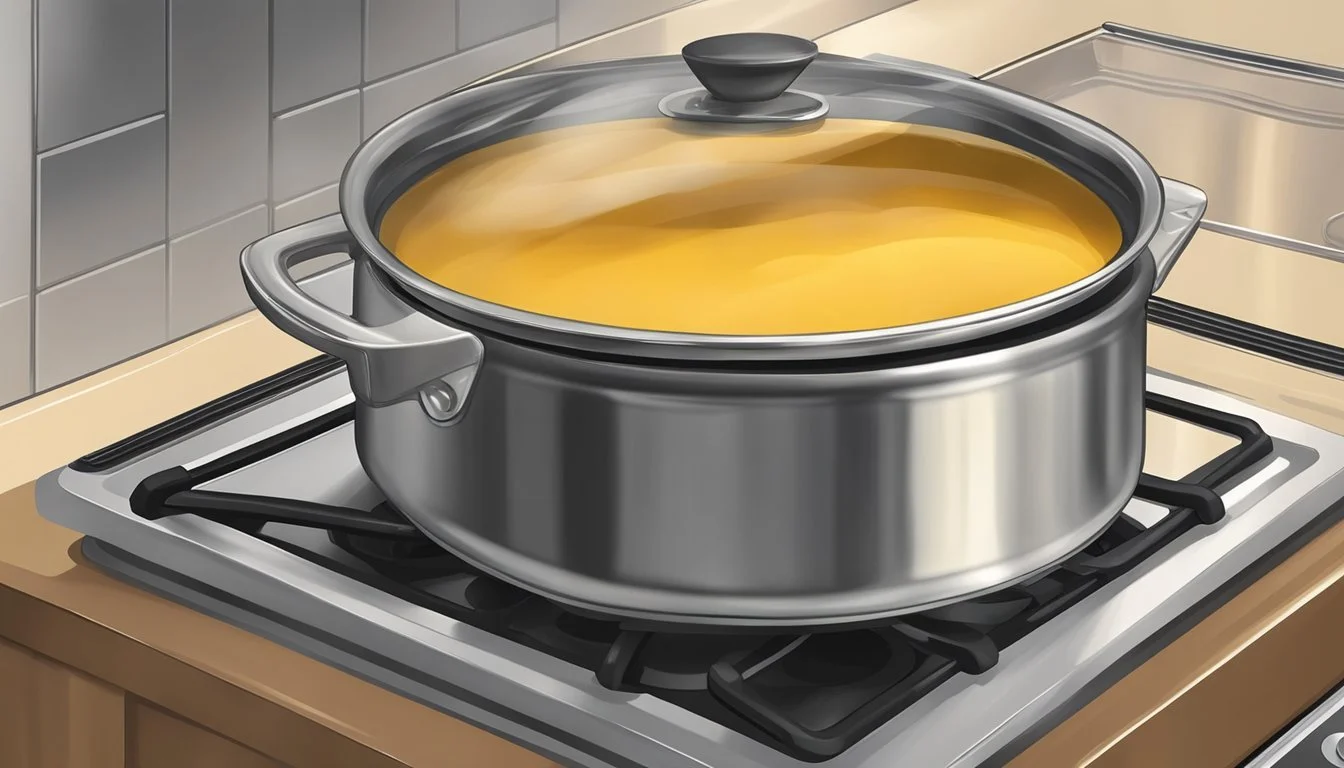Best Way to Reheat Acorn Squash Soup
Preserving Creamy Texture
Acorn squash soup is a beloved comfort food, celebrated for its nutty flavor and creamy texture. Reheating this soup, however, can be a delicate process as it can easily lose its smooth consistency if not done correctly. It is crucial to approach reheating with care to ensure that the soup maintains its velvety texture and the flavors remain as intended in the original recipe.
The key to successfully reheating acorn squash soup lies in gentle heat application and consistent stirring. While the soup is inherently creamy, uneven heating can lead to a separated or grainy texture, which detracts from the overall experience. Utilizing the correct reheating methods allows the flavors to meld together again, offering a result that is as satisfying as when it was freshly made.
There are multiple reheating techniques that can be employed, each with their own set of benefits, but some are better suited than others for acorn squash soup. Whether one opts to use a stovetop, oven, or microwave, understanding the attributes of acorn squash and the composition of the soup is essential. Selecting the most appropriate method and applying it with precision ensures the reheated soup's quality reflects the care that went into its preparation.
Selecting the Best Acorn Squash
Choosing the right acorn squash, a type of winter squash, is paramount for ensuring that the squash soup retains its creamy consistency after reheating. Attention to ripeness and proper storage are critical factors that influence the quality and flavor of the squash.
Identifying Ripeness
Ripeness in acorn squash is indicated by a hard, dull rind that resonates with a hollow sound when tapped. The squash should feel heavy for its size and feature a dull green skin with patches of orange. The absence of green spots on the orange sections also signifies a squash that has reached full maturity and is ready to be cooked into a soup.
Storage Tips for Freshness
Fresh acorn squash maintains its texture and flavor when stored properly.
Refrigerator: If one plans to consume acorn squash within 1-2 weeks, it can be kept in the refrigerator. This will slow down the ripening process while maintaining freshness.
Freezer: For long-term storage, acorn squash can be cubed and frozen. To ensure the quality:
Blanche the cubes before freezing to preserve texture and color.
Use airtight containers or freezer bags to avoid freezer burn.
By selecting a ripe acorn squash and following these storage tips, one ensures the best possible flavor and texture for their acorn squash soup.
Preparation Techniques for Acorn Squash
Prior to reheating acorn squash soup, it is essential to properly prepare the squash. The following subsections will detail the necessary steps one should take to ensure the acorn squash is ready to be transformed into a creamy, delicious soup base.
Washing and Cutting
To ensure cleanliness and remove any debris, one should thoroughly wash the acorn squash under running water. Using a sharp chef's knife, they should carefully slice 1 inch off the stem of the squash. This allows for a steady base to safely cut the squash in half from stem to base. Next, they need to scoop out the seeds and discard them, leaving the hollow center clean.
To Roast or to Simmer
One has two primary methods to cook acorn squash: roasting or simmering. For roasting, they should preheat the oven to 400 degrees Fahrenheit and prepare a baking sheet by lining it with parchment paper. They can then place the squash cut-side down onto the sheet and roast until it is tender. Alternatively, they can simmer the squash in a pot of broth until it becomes soft, which is a technique commonly used when preparing it for inclusion in soups (What wine goes well with soups?).
Creating a Base for Soups
Once the squash is tender, it can be pureed to create a base for soups. To enhance the flavor, they might add a drizzle of olive oil before roasting, which also prevents the squash from drying out. If they opt for simmering, incorporating the squash into a broth with aromatics like onions and celery can build a more complex flavor profile for the soup. After cooking, pureeing the tender squash until smooth serves as the perfect creamy foundation for a heartening acorn squash soup.
Crafting the Perfect Acorn Squash Soup
Creating a creamy and flavorful acorn squash soup involves careful selection of ingredients and techniques. From the initial roasting of the squash to the blending of aromatics and liquids, each step contributes to the overall richness and taste profile of the soup.
Roasted Acorn Squash Soup Essentials
To begin, one must roast the acorn squash to achieve a deep, caramelized flavor that will serve as the soup's foundation. A thorough roasting at 400 degrees F for approximately 40 to 50 minutes will do the trick. The squash should be halved and seeds removed before being brushed with olive oil and placed on a parchment-lined baking sheet. Roasting until the flesh is tender ensures that it will blend into a smooth, velvety consistency.
The Role of Aromatics
Aromatics, such as onions, garlic, and carrots, are sautéed to create a flavor base that complements the earthiness of the squash. One should sauté these ingredients in butter (for a richer flavor) or olive oil (for a vegan option) until they become tender and translucent. These vegetables not only add depth to the soup's flavor but also contribute essential nutrients.
Herbs play a significant role in flavoring the soup, with options like sage and thyme being popular for their savory notes that align well with the fall season.
Choosing the Right Liquids
The choice of liquid added to the soup can greatly influence its texture and creaminess. Traditional recipes may opt for vegetable broth or chicken broth, while water could be used for a lighter variant. For a richer, more indulgent soup, incorporating cream or milk adds a luxurious texture and flavor. However, for those seeking a vegan alternative, coconut milk offers a luscious creaminess without the use of dairy. This liquid should be simmered with the roasted squash and aromatics until all ingredients are well integrated and the flavors are melded.
By carefully selecting each component and adhering to these methods, chefs can craft an acorn squash soup that is rich in taste, creamy in texture, and perfect for a cozy fall meal.
Achieving Creamy Consistency
When reheating acorn squash soup, preserving the velvety texture is paramount. The process involves careful blending and consistency adjustments to ensure that the creamy quality of the soup remains intact.
The Art of Blending
Using an immersion blender or a stand blender allows for the soup to regain its smooth and creamy texture. When blending, one should do so in increments, checking the consistency regularly to avoid over-processing. If the soup was originally seasoned with herbs such as thyme, sage, or rosemary, the blending process can also help to distribute these flavors more evenly.
Adjusting Thickness
To adjust the thickness and bring back the soup's creamy consistency after reheating, consider adding a small amount of cream. Introduce the cream slowly, stirring continuously, to blend it thoroughly without causing separation. The goal is to achieve a balance that restores the soup’s body without making it overly rich or diluting its flavor profile.
Reheating for Best Results
To maintain the creamy consistency of acorn squash soup when reheating, one should consider the method used and the approach taken to prevent separation. The goal is to preserve the soup's flavor and texture that was achieved during the initial cooking process.
Optimal Reheating Methods
Microwave:
Power Setting: Use a medium power setting to avoid overheating.
Technique: Heat in intervals, stirring in between to distribute the warmth evenly.
Stovetop:
Temperature: Keep the flame low to medium-low.
Process: Gradually bring the soup to a simmer, stirring frequently to avoid scorching.
For storing leftovers, ensure that the acorn squash soup is cooled completely before placing it in an airtight container in the refrigerator. When reheating, only warm the portion needed to avoid multiple heat cycles that can degrade the soup's quality.
Preventing Soup Separation
Stovetop Simmering:
Adequately stirring while gently simmering ensures that the components of the acorn squash soup do not separate and maintains the soup's homogenous texture.
Microwave Technique:
Stirring the soup periodically during microwaving helps prevent the soup from separating and reduces the risk of hotspots.
When reheating in a microwave, it's also advisable to cover the soup with a microwave-safe lid to retain moisture and reduce the risk of drying out the edges or causing splatters.
Customizing Your Soup
Proper customization can elevate acorn squash soup with compatible flavors and textures, ensuring a richer dining experience.
Exploring Variations and Add-Ins
When considering variations and add-ins for acorn squash soup, one can enhance the depth of flavor by incorporating pumpkin or butternut squash. These substitutes offer nuanced taste differences while maintaining a similar creamy texture. To introduce warmth and a subtle spiciness, ginger is an excellent addition. One can also add sweet elements like apple for a balanced flavor profile. For a seamless integration of these ingredients, it is recommended to blend them into the soup once cooked.
Garnishes and Toppings
Cheese: A sprinkle of grated cheese, such as aged cheddar, can add a savory dimension.
Croutons: Homemade or store-bought croutons offer a pleasant crunch.
Pepitas: Toasted pepitas provide a nutty flavor and a contrasting texture.
Bacon: Crumbled bacon imparts a smoky, savory character.
Fresh Herbs: A garnish of fresh thyme or other herbs adds a hint of earthiness.
Sweet Drizzles: A drizzle of maple syrup or honey can complement the soup's inherent sweetness.
Applying these toppings not only creates a visually appealing dish but also enriches the overall flavor profile of the acorn squash soup.
Health Benefits and Nutritional Value
Acorn squash offers a wealth of health benefits largely due to its high nutrient density, which contributes to the maintenance of good health and well-being.
Vitamins and Minerals in Acorn Squash
Rich in essential vitamins and minerals, acorn squash is an excellent addition to a balanced diet.
Vitamin C: One cup of acorn squash provides a significant portion of the recommended daily value for vitamin C, an antioxidant that supports immune function and skin health.
Potassium: This nutrient helps regulate blood pressure levels and is abundant in acorn squash.
Magnesium: Necessary for many biochemical reactions in the body, magnesium is another key mineral found in acorn squash.
Fiber: Acorn squash is a good source of dietary fiber, which aids in digestive health and can help maintain a healthy weight.
Acorn squash nutrition information per 1 cup (205g):
Calories: 115
Protein: 2.3g
Carbohydrates: 30g
Fat: 0.3g
Fiber: 9g
Dietary Considerations
Acorn squash suits a variety of dietary needs. It is inherently gluten-free, making it a safe choice for those with gluten intolerances or celiac disease. Additionally, its natural composition allows it to fit into both vegetarian and vegan diets. Furthermore, the fibrous nature of acorn squash makes it beneficial for those seeking foods that support satiety and blood sugar control.
Preservation Beyond the Meal
Acorn squash soup can retain its creamy consistency beyond its initial serving when proper preservation methods are employed, caring for both freezing and refrigeration procedures.
Freezing and Thawing Best Practices
Freezing the soup properly is crucial for maintaining its quality. The soup should be allowed to cool to room temperature before being placed in the freezer. Use airtight, freezer-safe containers to prevent freezer burn and fill containers to leave a small gap at the top, as the soup will expand when frozen. Label the containers with the date of freezing; acorn squash soup can be stored in the freezer for up to 2-3 months. When ready to use, thawing it correctly ensures the soup retains its texture and taste. Thaw the soup in the refrigerator overnight, or for quicker thawing, submerge the container in cold water, changing the water every 30 minutes.
Cool soup to room temperature
Use airtight, freezer-safe containers
Leave a small gap for expansion
Label with the freezing date
Store for up to 2-3 months
Thaw in the refrigerator or cold water bath
Extending Soup Shelf Life
To maximize shelf life in the refrigerator, the acorn squash soup should be stored in an airtight container and placed in the refrigerator within two hours of cooking. The soup typically lasts for 3 to 4 days when refrigerated at or below 40°F.
Store in an airtight container
Refrigerate within two hours of cooking
Maintain refrigerator temperature at or below 40°F
Consume within 3 to 4 days
It's important for individuals to taste the soup before reheating to ensure it has not spoiled. One should always err on the side of caution if the soup's aroma, texture, or appearance is questionable.
Serving and Pairing Suggestions
When serving acorn squash soup, a thoughtful selection of accompaniments and drink pairings can enhance the dining experience. Choosing options that complement the creamy consistency and rich flavors of the soup is essential.
Accompaniments for Acorn Squash Soup
Salads: A crisp, leafy salad with a light vinaigrette dressing can add a refreshing contrast to the soup's creaminess. Opt for salads that incorporate nuts and seasonal fruits to echo the autumnal theme of acorn squash.
Stuffed Acorn Squash: For a heartier meal, serve a side of stuffed acorn squash. Fill halves of roasted squash with a mix of quinoa, veggies, and a touch of cheese to create a satisfying dish that pairs seamlessly with the soup.
Wine and Beverage Pairings
Wine: A full-bodied white wine, such as Chardonnay, harmonizes with the richness of the soup, accentuating its depth of flavor without overwhelming it.
Stock-based Beverages: For non-alcoholic options, beverages that include a hint of stock or spices can resonate with the warm undertones of the soup, enhancing its savory aspects.
Conclusion
To ensure acorn squash soup maintains its creamy consistency when reheated, chefs must employ careful techniques. It's paramount to avoid high temperatures that could cause separation or loss of the velvety texture that defines such soups.
Gentle Reheating: It's recommended to reheat the soup over low to medium heat on the stovetop, stirring constantly. This method allows for heat to distribute evenly without bringing the soup to a boil, which can compromise the consistency.
Batch Size: If one has a larger quantity, it’s advisable to reheat in smaller portions. This allows for better control over the temperature and ensures consistent reheating throughout.
Microwaving: For a quick method, microwaving is an option. However, it’s vital to use a low power setting and to stir the soup periodically to distribute heat evenly.
Storage and Reheating: For soups such as acorn squash or butternut squash soup, optimal storage prior to reheating makes a considerable difference. Experts suggest storing the soup in airtight containers and ensuring it is properly cooled before refrigeration.
Adding Liquid: If the soup has thickened in storage, one may consider adding a small amount of broth to thin it slightly. This will help restore the right consistency without diluting the flavor significantly.
Lastly, the reheating approach should align with the original soup recipe's preparation method to preserve the integrity of flavors. Adhering to these tips not only maintains the texture but also ensures that the flavors remain as delightful as when freshly prepared.












